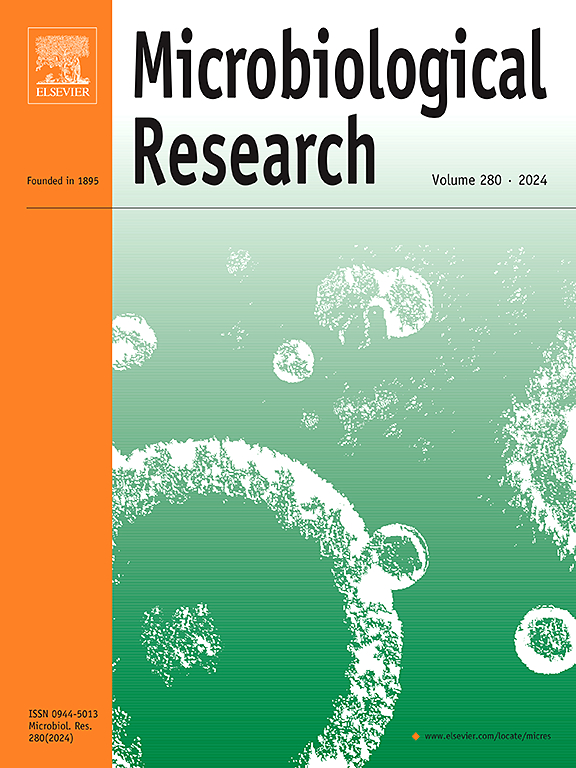推测的SET结构域蛋白在辣椒疫霉产孢和致病性调控中起重要作用
IF 6.9
1区 生物学
Q1 MICROBIOLOGY
引用次数: 0
摘要
辣椒疫霉(Phytophthora capsici)是一种丝状卵菌,对辣椒(Capsicum annuum)、番茄(Solanum lycopersicum)、南瓜(Cucurbita pepo)、茄子(Solanum melongena)、蚕豆(Vicia faba)和利马豆(Phaseolus lunatus)等多种植物物种的根腐病、果腐病、叶枯病和其他经济破坏性疾病负责。这种病原体在全球范围内造成水果和蔬菜作物的重大产量损失。包括效应蛋白和表观遗传调节剂在内的多种分子参数在辣椒辣椒的生理病理发育中起着重要的调节作用。在这里,我们鉴定了56个含有SET结构域的辣椒辣椒蛋白,其中35个被预测为潜在的效应蛋白。转录组学分析显示13个候选效应基因在感染过程中上调,提示它们在致病性中起作用。我们使用CRISPR-Cas9和同源重组策略成功地删除了一个效应蛋白PcSET-C (DVH05_022087)和两个非效应蛋白PcSET-B (DVH05_004260)和PcSET-A (DVH05_000194)。表型分析显示,PcSET-A和PcSET-B基因的靶向缺失显著损害了营养生长,而ΔPcset-C菌株的生长与野生型菌株相似。此外,我们发现有针对性地破坏这三个基因导致无性孢子的减少,并几乎完全消除了ΔPcset-A, ΔPcset-B和ΔPcset-C菌株对不同辣椒辣椒易感植物的致病性或毒力。然而,本研究中所研究的三个含SET结构域基因的靶向替换对辣椒辣椒虫孢子释放没有明显的不利影响。这些发现揭示了SET结构域蛋白在辣椒辣椒的形态和病理发育中的重要作用,并强调了pcset作为疾病控制的潜在靶点。本文章由计算机程序翻译,如有差异,请以英文原文为准。
Putative SET domain-containing proteins play significant roles in regulating sporulation and pathogenicity in Phytophthora capsici
Phytophthora capsici is a filamentous oomycete responsible for root rot, fruit rot, leaf blight, and other economically destructive diseases in multiple plant species, including pepper (Capsicum annuum), tomato (Solanum lycopersicum), squash (Cucurbita pepo), eggplant (Solanum melongena), faba bean (Vicia faba), and lima bean (Phaseolus lunatus), among others. The pathogen causes significant yield losses in fruit and vegetable crops globally. Multiple molecular parameters, including effector proteins and epigenetic modulators, play vital roles in modulating the physio pathological development of P. capsici. Here, we identified 56 SET domain-containing proteins in P. capsici, with 35 predicted as potential effectors. Transcriptomic analysis revealed the upregulation of 13 candidate effector genes during infection, suggesting their roles in pathogenicity. We successfully deleted one effector, PcSET-C (DVH05_022087), and two non-effector proteins, PcSET-B (DVH05_004260), and PcSET-A (DVH05_000194), using CRISPR-Cas9 and homologous recombination strategies. Phenotypic analysis showed that targeted deletion of the PcSET-A, and PcSET-B gene significantly impaired vegetative growth, while ΔPcset-C strains displayed growth like wild-type strains. Additionally, we showed that targeted disruption of all three genes resulted in reduced asexual sporulation and almost completely abolished the pathogenicity or virulence of ΔPcset-A, ΔPcset-B, and ΔPcset-C strains on different P. capsici-susceptible plants. However, targeted replacement of the three SET domain-containing genes investigated in this study has no significant adverse effects on zoospore release in P. capsici. These findings provide insights into the crucial role of SET domain-containing proteins in both morphological and pathological development of P. capsici and underscore PcSETs as potential targets for disease control.
求助全文
通过发布文献求助,成功后即可免费获取论文全文。
去求助
来源期刊

Microbiological research
生物-微生物学
CiteScore
10.90
自引率
6.00%
发文量
249
审稿时长
29 days
期刊介绍:
Microbiological Research is devoted to publishing reports on prokaryotic and eukaryotic microorganisms such as yeasts, fungi, bacteria, archaea, and protozoa. Research on interactions between pathogenic microorganisms and their environment or hosts are also covered.
 求助内容:
求助内容: 应助结果提醒方式:
应助结果提醒方式:


